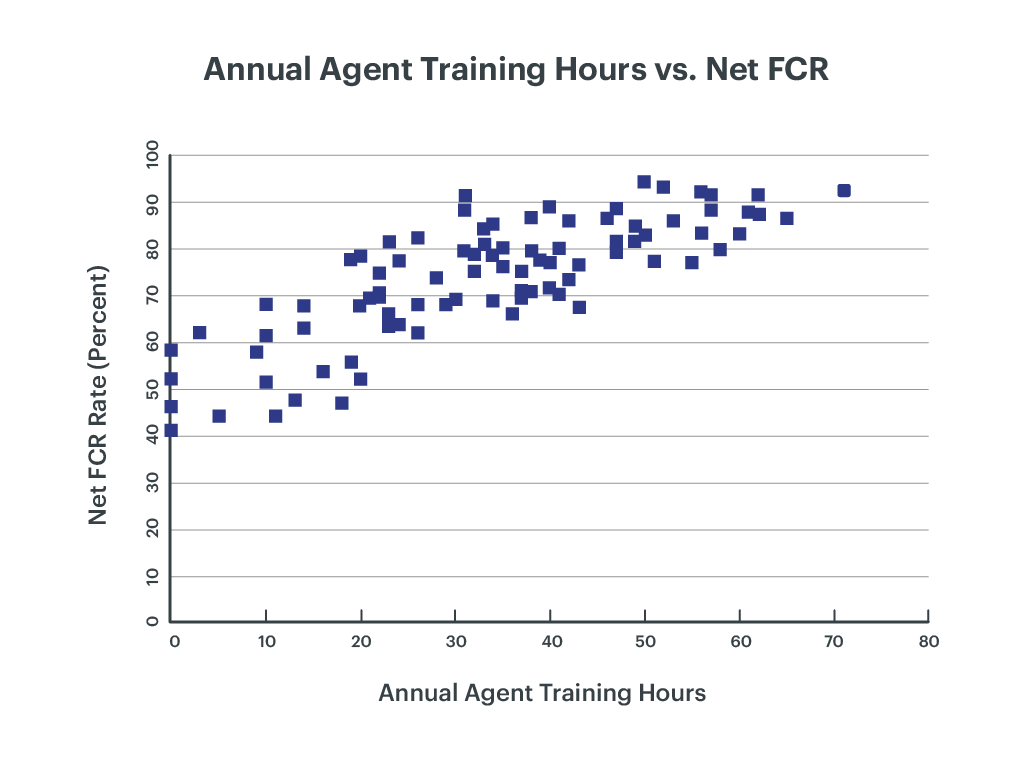26 Tips for Improving Your First Call Resolution Rate
July 1, 2021
Contact Center
First Call Resolution (FCR) is the most important metric your contact center can measure. It captures the efficiency of your team, tells you how well you’re serving customers, and highlights what needs work.
Your FCR rate is the pulse rate of your organization. When it’s high, operating costs are minimized and customers are happier. When it’s low, your team is wasting valuable energy and resources on processes that aren’t working. To really drive value for your customers, it’s imperative that your team optimizes your processes and practices to improve first call resolution.
Why Is Improving First Call Resolution So Critical?
Low FCR drives costs. High FCR drives revenue.
If your contact center’s sweet spot is where happy, productive agents and satisfied, loyal customers meet, you need to concentrate on FCR.
The higher your first call resolution rate, the more positive your customer experience and the higher your customers’ lifetime value (CLTV). FCR is also a good indicator of whether your agents like their work. And it directly impacts your center’s bottom line by improving margins, reducing churn, and turning customers into brand evangelists.
It’s as important as any data point you can track.
If your center is truly invested in producing sustainable results, all these factors matter. They matter so much, in fact, that the concept of “improving FCR” has been touted by CX experts as the Next Big Thing for years…but it’s not the Next Big Thing.
It’s the thing.
Digging in to discover why your process isn’t working is a complex but valuable exercise. Every extraneous customer service call your agents process costs your center money, and in many important ways. It’s a problem that simply won’t solve itself.
How to Improve Your First Call Resolution Rate
A lot of factors impact FCR. Improving your score isn’t as simple as scheduling a one-day customer service training session or implementing better software. Let’s talk about the actionable steps your center can take to consistently improve its First Call Resolution rate.
We’ve divided these First Call Resolution tips into five distinct categories:
- Assess the Situation
- Set Your Strategic Priorities
- Equip Your Customer Service Team
- Adjust Your Operation
- Measure Your Progress
Let’s take them one by one.
Assessing the Situation
1. Measure your First Call Resolution rate.
There are several ways to do this effectively. Tracking how many calls come in from the same number within a set period of time is the most straightforward. Speech analytics can also help by looking for indicators like, “Last time I called…” You can also use real-time, agent-level customer feedback requests to ask customers whether their issue was resolved.
2. Conduct a contact driver analysis across internal channels.
Which internal issues are causing customers to reach out? Misalignment among business teams and broken internal processes can create roadblocks for the customer down the line. Understanding the point at which the customer journey went off the rails can improve First Call Resolution from the inside out.
3. Get to the bottom of delayed resolution.
Do most customer calls seem like endless variations on the same two or three issues? Identifying the most common (and most problematic) customer pain points – tech troubles, instruction confusion, price concerns, etc. – is a necessary step in raising your FCR rate. Your customers’ problems become your agents’ problems.
4. Invest in the right platforms.
First Call Resolution is a highly nuanced metric; detailed customer histories, call tags, agent routing capabilities, and task automation are all critical to understanding exactly what’s causing FCR to flag. If you don’t already have access to the data you need to inform improvement strategies, invest in customer service technology that collects the kind of granular customer intel that can be useful to your agents on the ground.
5. Measure CSAT frequently.
Customer satisfaction is directly related to FCR. Consider the variables that go into your center’s Customer Satisfaction (CSAT) rating holistically, highlighting the relationship between FCR and NPS. When FCS goes up, most of the other metrics that matter to your business will too.
6. Segment customers based on common issues.
Perform a deep-dive analysis on the customer “buckets” that result in the most repeat problems. Remember that a problem that takes too long to solve isn’t necessarily as inefficient as a problem requires takes too many calls to remedy.
7. Identify your weak spots.
Low FCRs don’t happen in a vacuum. They’re the result of bad policies, knowledge gaps, and ineffective cross-organizational communication. Try to a gain an understanding of whether or not low FCR is an agent problem, a technology problem, a positioning problem, or some combination thereof.
Setting Your Strategic Priorities
8. Identify KPIs to avoid conflicting priorities.
Your sales team should be very clear on which metrics matter. If your center’s goal is to improve its First Call Resolution rate, the quality of each customer interaction takes precedence over your team’s Average Handle Time (AHT) per-call, for example.
9. Develop a cross-channel update strategy.
To keep customers happy, contact center management should always be in the loop on new marketing initiatives, updated products or services, price changes, and any other business shifts. Understanding what to expect from calls is critical for developing a successful process for issue resolution.
10. Strive for minimal customer effort.
By the time a customer reaches out to your team, they’ve already exerted considerable effort. Reducing friction on the customer journey leads to more satisfied customers and happier agents. Anticipating the customer’s needs before they call in reduces residual service contacts and directly improves FCR.
11. Improve your policies.
Great agents can be hamstrung by short-sighted policies. Monitor scenarios in which agents must say “no” and determine what usually drives that response. Empowering agents to solve more problems themselves can instantly boost First Call Resolution scores.
12. Avoid transfers whenever possible.
Give agents the authority to make decisions that speed up resolution and reduce the complexity of the customer’s issue. Agents with agency are always more incentivized to reduce call-backs.
13. Treat problems as sales opportunities.
Your team should always be striving for Service Delivery +1. That means going beyond “solving” the customer’s issue to create a customer experience that’s personal and memorable (and that might even include an upsell!). Data measurement and robust training are essential to turning a negative into a positive.
Equipping Your Customer Service Team to Improve First Call Resolution
14. Prioritize FCR techniques in training.
Emphasize the importance of in-depth product knowledge and cross-channel communication strategies in training. Identify which agents have the highest instances of repeat calls and devote micro-coaching sessions to improving FCR.
Agent Training vs. First Call Resolution © 2011 MetricNet, LLC and United Business Media LLC. All rights reserved.
15. Cross-train agents.
Agents can’t be experts in everything, but they can be touch points for a lot of things. The more information agents are armed with, the better they can navigate a difficult customer or complex issue. Schedule regular customer service coaching sessions that give agents a high-level picture of what other departments are working on, doing now, and considering for the future.
16. Make crucial information readily available for agents.
Software that captures customer history data is a great resource for agents to use before and after they encounter roadblocks. Give agents a handy list of support services (billing, tech support, etc.), so they can consult without ending or escalating calls.
17. Repeat and reflect.
Train agents to succinctly isolate the issue that led to the contact and talk it through with the customer before ending the call. This ensures everyone is on the same page regarding how thoroughly the problem was handled. It’s information that can also be used to predict future call-back rates.
Adjusting Your Service Operations
18. Route customers to the right agents.
By analyzing contact behavior of different customer groups, you can more effectively route contacts to the right agent(s) for their particular issue. Consider demographics, purchase history, and even agent personality type.
19. Emphasize staying on point.
Customer contacts that are resolved the first time are usually the most straightforward. In training agents on FCR, teach them to isolate the reason for the call and stay on topic through the use of directive questioning.
20. Promote “Total Contact Ownership.”
When one agent follows the call from start to finish, first contacts are resolved more often. Agents should be able to collaborate with other personnel directly to solve issues in real time. Your contact center isn’t a silo; it’s a link in a chain.
21. Communicate clearly with customers.
Overkill is good for First Call Resolution. Agents should be trained to go out of their way to make sure customers are clear on all the facets of their case so they’re less likely to call again for more information later.
22. Focus on next issue avoidance.
Train agents to anticipate future inquiries based on the issue at hand. Develop a process through which management reaches out to customers directly if a repeat call is likely. This improves CSAT scores and reduces the number of frustrated customers agents have to work with.
23. Continually ask for agent input.
Agents know best what’s driving calls, regardless of what the data says. Schedule regular feedback sessions to gain insight from both high- and low-performing agents on why customers are reaching out (and what’s getting in the way of resolution). Adjust your strategy accordingly.
Measuring Your Progress
24. Touch base with customers.
Leave customer feedback tickets open for at least 24 hours. Always ask customers to confirm whether their issue has been resolved both on the phone and through post-contact surveys. The customer has the final say on whether a problem is “done in one” or destined to remain on the books.
25. Ask agents to evaluate one another.
Involving agents in mystery shopping calls is doubly enlightening: Hearing how other agents handle (or don’t handle) common customer issues can be an incredibly useful training exercise. These calls also provide actionable data to better train the unknowing agents who field them. Ask mystery agents to report their experience to their peers directly and/or anonymously.
26. Use FCR as an agent performance metric.
When agents understand their First Call Resolution performance is being evaluated, FCR rates go up. Agents with clearly defined goals are more proactive. They’re likely to go the extra mile to solve an issue the first time around and to report patterns they’re noticing to management.
It’s Time to Tackle and Improve First Call Resolution
It’s time to make First Call Resolution a DEFCON 1 priority for your management team. Unresolved customer issues are costing you money. They’re losing you long-term customers and they’re contributing to call center attrition.
High FCR is the all-important customer metric you’re not taking seriously enough.
Leading brands are investing in the platforms and technologies required to stay in tune with today’s customers. At the end of the day, your customers know best whether or not their issue was resolved. Are you asking them the right way?
Medallia Agent Connect clients include FCR questions in their real-time customer feedback requests. With a response rate that’s ten times the industry average, Medallia Agent Connect gives managers the First Call Resolution data they need within minutes. That data is catalyzing real change, fast.
Ready to ignite agent performance? Check out Medallia’s guide, 4 Steps to Supercharge Contact Center Agent Performance, to learn how leading contact centers are putting the right systems and processes in place to achieve success.
This post was originally published on July 17, 2018 and has since been updated.








